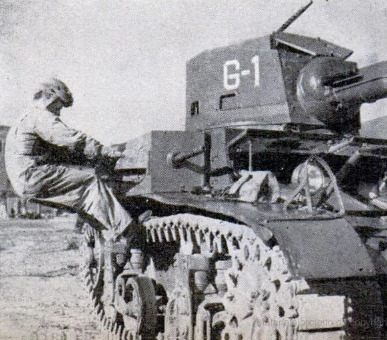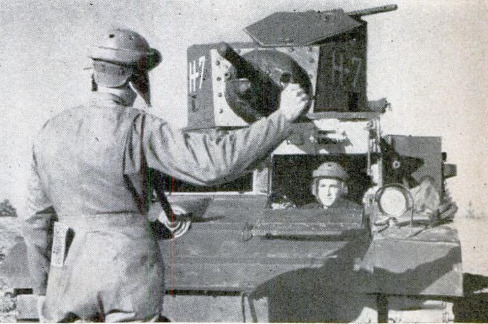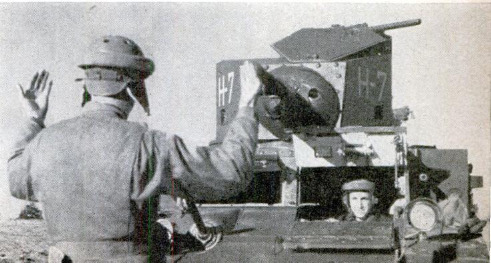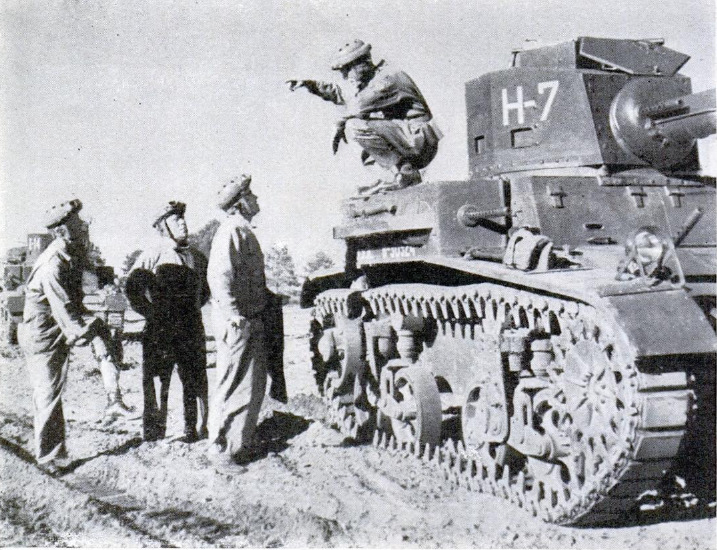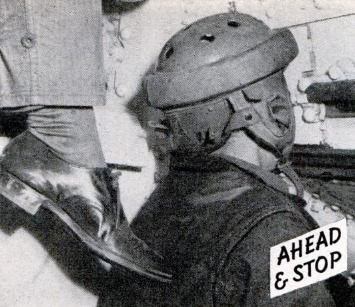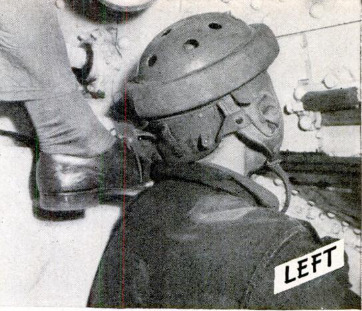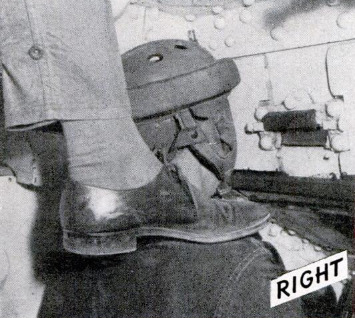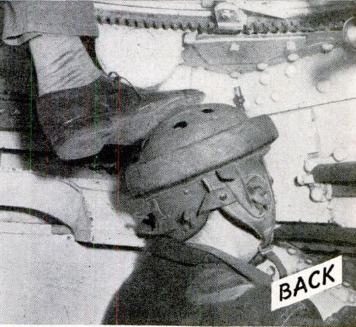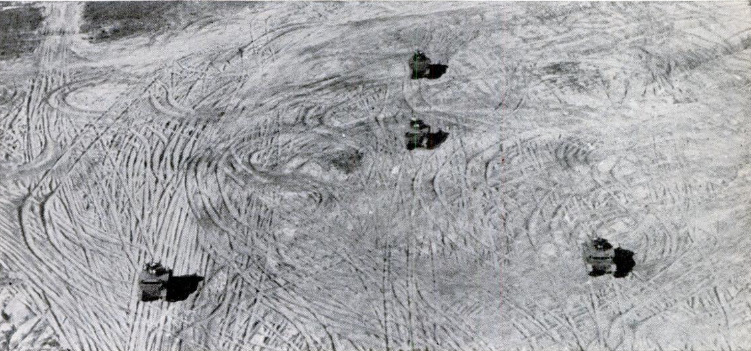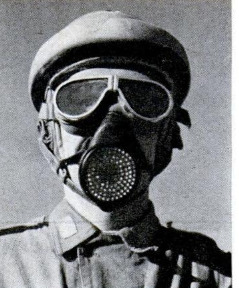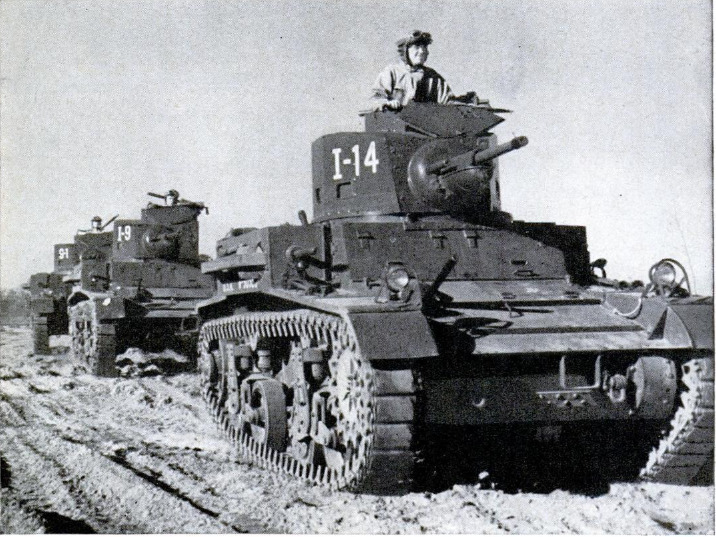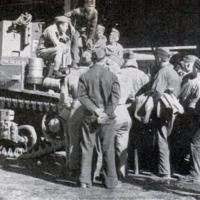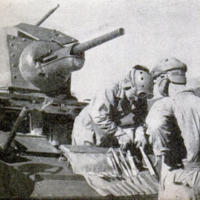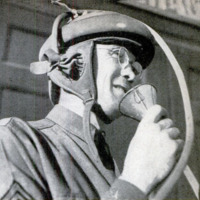-
Title (Dublin Core)
-
How a rookie solider learns to handle a tank
-
Article Title and/or Image Caption (Dublin Core)
-
Title: How a rookie solider learns to handle a tank
-
extracted text (Extract Text)
-
MASS-PRODUCTION education has
M been adopted by the Army to train
rookies for the recently organized Armored
Force. And it is working so well that
graduates are pouring from the Armored |
Force School at Fort Knox, Ky., into the
service at the rate of 400 to 500 a week.
Because tanks are the backbone of the
force, a large percentage of the graduates
are “tankers.” That means that they have
completed a rigorous three-months course
in which they were taught to drive and
care for a tank, read maps, use and main-
tain rifles, machine guns, and 37-mm. or
75-mm. guns, the latter depending
on whether they will be assigned to
light tanks which are fitted with the
37-mm., or medium tanks which
carry the 75's.
The Armored Force is proving
highly popular with recruits, but
soldiers with a yearning to become
“hell-buggy” drivers have a good
chance of getting what they want.
By next June the Army will have
four armored divisions, with 1,000
light and 400 medium tanks, plus
ten reserve tank battalions of 54
light or medium tanks each. Since
each member of a tank crew—four
men in a light tank, five in a
medium—must be able to fill al-
most any job in the tank, that leaves
plenty of room for trained tankers.
And the Army is already planning
another six armored divisions.
There are no special requirements
for tankers, though soldiers with
mechanical ability and a good record
in their general aptitude test are
preferred. But a recruit has to
satisfy his instructors in the course
that he will make a tanker, or he
is dropped.
Before a recruit even approaches
a driving lesson, he has to learn the
general characteristics of the type
of tank to which he will be assigned.
If it is an M2Ad, the standard army
light tank, weighing 11 1/2 tons, he
learns that it will make better than
50 miles per hour on a highway,
and up to 30 cross-country, and that
our army officers consider it the best
little juggernaut of its kind in the
world, superior to anything used by
European armies.
If he is going to a medium-tank
regiment, he gets an earful about
the M2, a 20-ton job officially
capable of 32 miles per hour on
highways and up to 20 cross-country.
Then things come thick and fast.
One day the budding tanker takes
driving lessons. The next day he
will work in classrooms, studying
tracks, engines, transmissions, and
other complicated parts.
The first steps in the driving are
learned with the tank standing still,
as even a light tank costs more than
$20,000, and the Army doesn't want
to spoil any.
The student is plopped into the
driver's seat on the left side of the
tank. Under each hand he finds a
“joy-stick,” each with an electric
trigger connected to fixed machine
guns in the sides which are aimed by aiming
the whole machine. The only familiar
items will be the clutch and accelerator,
which are like those in an automobile.
“Pull back on the right stick, and the
tank will turn to the right,” he is told. The
left one will turn the tank to that side.
Because the control sticks are attached
to two brake bands in the transmission,
each of which controls one track, pulling
back on both at once will stop the tank.
It sounds easy until the student finds that
to operate the gearshift lever, mounted on
a huge six-speed transmission, he has to
let go of one control stick. The trans-
mission, incidentally, snuggles right along-
side his right leg, and gets unpleasantly hot
when the tank is under way.
Once he has mastered the theory with the
tank at rest, he learns to operate the vehicle
on smooth ground, first in low gear, later in
higher gears and at higher speeds. The
final phase is cross-country work, which
means anything from bouncing over stone
walls at 20 miles per hour to burrowing
through ditches and shoving over three-
inch trees. He must learn, for instance that
if he doesn’t “give her the gun,” when his
tank noses down a steep pitch, it may roll
right over on its back.
All this has been done with the armor
plate open in front of the driver, enabling
him to see where he is going. Now he must
learn to drive the tank when it is “buttoned
up,” with all the armor in place and his only
means of looking out a narrow slit. He
begins to develop sensitive shoulders, be-
cause the tank commander, who has slits
on all sides of him and can therefore see
all around even when the turret top is
closed, directs the driver with the toe of
his boot. This is necessary because the in-
side of a tank under way is noisier than
the proverbial boiler factory, and even
shouted commands are inaudible.
In tanks equipped with radios, such as
platoon and company commanders’, the
assistant drivers must be radio operators
as well as gunners and drivers. Recruits
with an ear for code are trained for this
duty after learning the other aspects of
tanking. It is not an enviable position, be-
cause in action the operator must be able
to tune his set and hear what is coming in,
and send as well, with hot shell casings
from the 37-mm. gun in the turret and the
machine gun beside his
seat pouring down upon
his head, possibly down
his neck, if he forgot to
“ button his collar.
To protect the tankers
from bruises when the
tank is bumping across-
country, special crash
helmets are provided,
though even with them
tankers have been knocked
unconscious when the
vehicle took a particular
vicious bump at high
speed. Khaki overalls are
standard uniforms, and
they rarely stay clean
long. After each day's
run, a tank crew must
inspect their machine, re-
port any necessary repairs to the company
commander, fuel and lubricate the buggy
for the next day, and, if at a home station,
clean the tank as well.
In the meantime, the tanker has been
learning how to care for and make minor
repairs to his tank and its power plant.
He has studied the general theory of the
four-cycle, internal-combustion engine;
then he specialized in the
type of engine which he
will find in the regiment
to which he will go after
graduation. In the M2A4
this is either a seven-cyl-
inder, radial, air-cooled
250 - horsepower gasoline
engine, or a Diesel of sim-
ilar type and power. In
the M2 it is a more pow-
erful radial gas engine.
The end of the school
course doesn’t mean the
end of his training for a
tanker, however. After he
is assigned to a regiment,
there are cross-country
marches, gunnery prac-
tice, and night maneuvers
to keep his mind on his job.
For the more ambitious recruits who want
quick promotion, there are study courses
and examinations. And although a tanker
probably won't find a job driving a tank
when he returns to civilian life, it's a safe
bet that he will be far wiser about the
workings of gears and internal combustion
engines. He may even find that he is a bet-
ter automobile driver.
-
Contributor (Dublin Core)
-
David M. Stearns (article writer)
-
Language (Dublin Core)
-
Eng
-
Date Issued (Dublin Core)
-
1941-03
-
pages (Bibliographic Ontology)
-
56-60
-
Rights (Dublin Core)
-
Public domain
-
Archived by (Dublin Core)
-
Sami Akbiyik
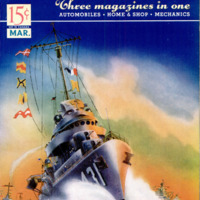 Popular Science Monthly, v. 138, n. 3 1941
Popular Science Monthly, v. 138, n. 3 1941



